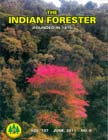Vegetational Structure of Rhododendrons and Associate Species in Western Himalaya
DOI:
https://doi.org/10.36808/if/2011/v137i6/12371Keywords:
Rhododendron spp., Importance Value Index (IVI), Quercus semicarpifolia, Garhwal HimalayaAbstract
The genus Rhododendron constitutes a dominant combination in temperate, subalpine and alpine vegetation of the Western Himalaya. In this study, we examined the species composition, diversity, dominance and importance value index of Rhododendron and associate tree species along with altitudinal gradient in Garhwal Himalaya at three forest sites. Rhododendron arboreum and H. barbatum emerged as a dominant species on the site I, lies (2100-2900 m) with the IVI values 122.48 and 50.67 respectively. Quercus semicarpifolia, Taxus baccata and Abies pindrow were the main associate species of these two Rhododendron species. At site second which is forming the transition zone of timber line and alpine postures (3000 to 3600 m) R. campanulatum was pure patches. At site ill which lies at an altitude of 3900 to 4200 m, R. anthopogon and R. lepidotum were found in pure patches as well as mixed form. The associate species were perennial herbs and grasses. The highest IVI was found in R. anthopogon (195.80) followed by R. campanulatum (185.07) and minimum IVI was recorded in case of R. barbatum (50.67) among Rhododendrons. However, Quercus semicarpifolia recorded highest IVI (82.93) followed by Taxus baccata and minimum IVI value was observed in Abies pindrow (7.49) among associates.Downloads
Download data is not yet available.
Downloads
Published
2011-06-01
How to Cite
Nautiyal, S., Razvi, S., & Prasad, S. (2011). Vegetational Structure of Rhododendrons and Associate Species in Western Himalaya. Indian Forester, 137(6), 751–756. https://doi.org/10.36808/if/2011/v137i6/12371
Issue
Section
Articles
License
Unless otherwise stated, copyright or similar rights in all materials presented on the site, including graphical images, are owned by Indian Forester.





